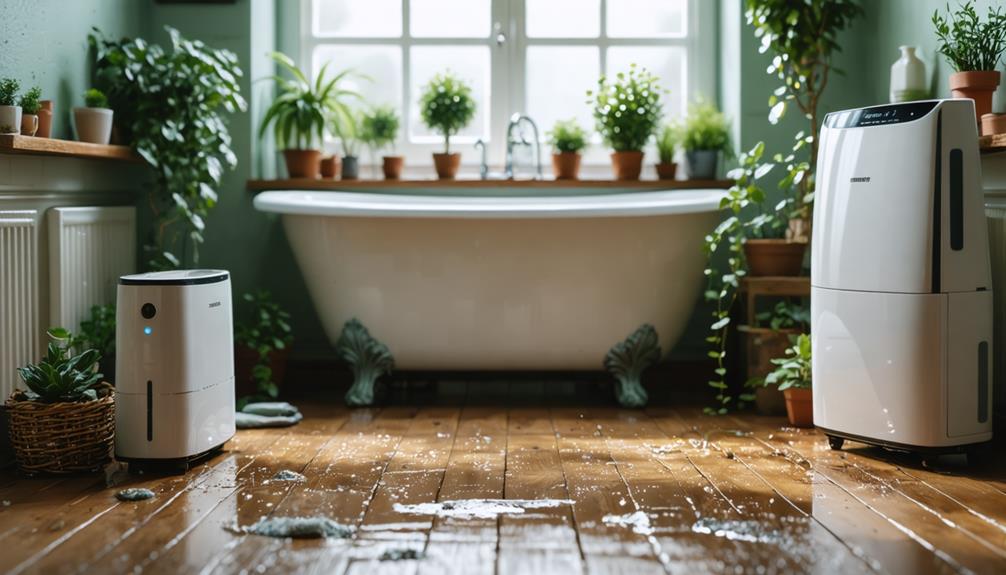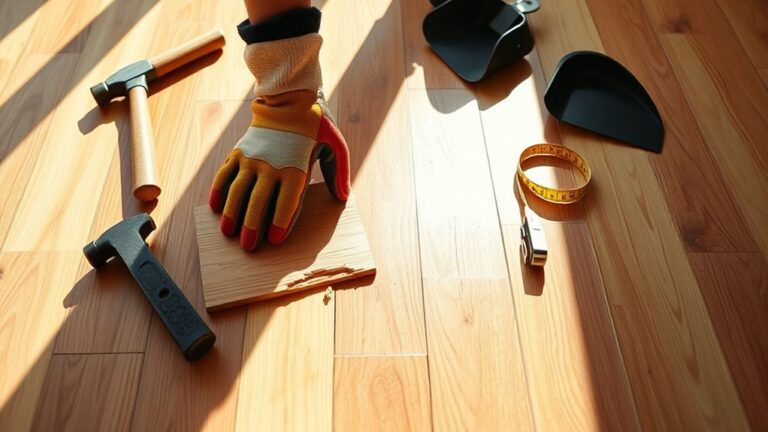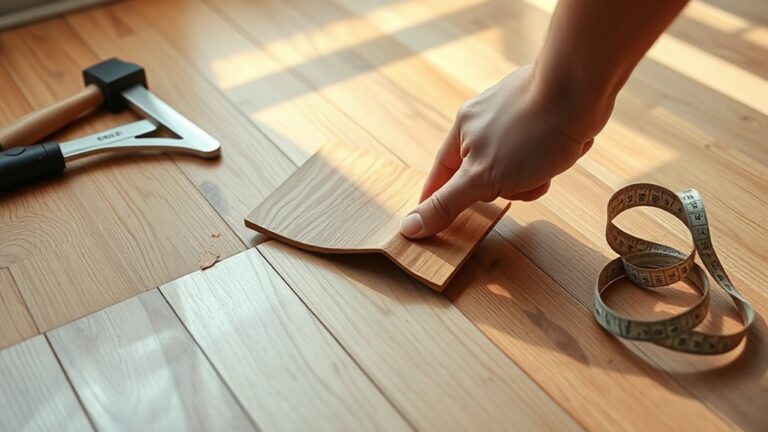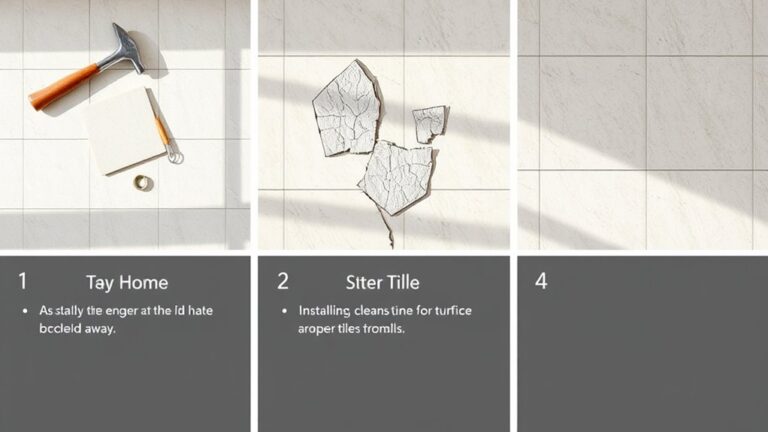To prevent mold in high-moisture flooring areas, monitor humidity levels, keeping them between 30-50%. Choose moisture-resistant materials like ceramic tile or waterproof vinyl to minimize mold risk. Guarantee proper ventilation with exhaust fans and open windows to reduce humidity. During installation, use seamless techniques and mold-resistant underlayment to create effective barriers against moisture. Regularly inspect your flooring and promptly address any spills or leaks. Establish a consistent cleaning routine to eliminate dirt and moisture accumulation. By focusing on these strategies, you can effectively manage mold growth and maintain a healthy environment, revealing more insights on preventing mold as you explore further.
Understanding Mold Growth
Understanding mold growth is fundamental for maintaining a healthy indoor environment. Mold thrives in high-moisture conditions, particularly when relative humidity exceeds 60%. To prevent mold growth, it's imperative to maintain indoor humidity between 30% and 50%. When warm, humid air contacts cooler surfaces, condensation occurs, creating an ideal environment for mold on porous materials. This underscores the importance of controlling moisture levels in your home.
In high-moisture areas like bathrooms, kitchens, and basements, mold can develop rapidly—often within 24 to 48 hours—if spills or leaks aren't addressed. Immediate cleanup is essential in these spaces to prevent an infestation. You should also be aware that mold and mildew can flourish in hidden locations, such as behind walls or under carpets, making regular inspections necessary.
Effective moisture control is fundamental to avoid mold growth. Utilizing dehumidifiers to maintain relative humidity can considerably mitigate the risks associated with dampness. Proper ventilation also plays an important role; confirm that your home's airflow is sufficient to prevent moisture accumulation.
In essence, understanding the factors that contribute to mold growth empowers you to take proactive measures. By controlling moisture and monitoring relative humidity, you can create an indoor environment that discourages mold, promoting overall health and well-being. Taking these steps not only protects your living space but also grants you the freedom to enjoy a cleaner, safer home.
Effective Flooring Choices
When selecting flooring for moisture-prone areas, it's essential to take into account materials that resist water damage, such as ceramic and waterproof vinyl. These options not only prevent mold growth but also guarantee durability and ease of maintenance. Conversely, you should avoid wood and carpet flooring, as their porous characteristics can trap moisture and promote mold development.
Best Flooring Options
Choosing the right flooring is crucial not only for aesthetic appeal but also for preventing mold growth, especially in moisture-prone areas of your home. Ceramic tile stands out as a top choice, thanks to its non-porous nature and durability. This flooring option resists water damage effectively, making it perfect for bathrooms and kitchens where mold problems frequently arise.
Vinyl tile is another excellent option. Crafted from durable PVC, it offers versatility, affordability, and longevity, with a lifespan exceeding five years. Its resistance to moisture is significant, allowing you to enjoy various designs without compromising on your goal to prevent mold and mildew.
Both ceramic and vinyl tiles also utilize seamless installation techniques, which minimize seams and gaps—crucial for reducing moisture penetration. Regular maintenance and cleaning of these surfaces are essential; they inhibit mold growth and contribute to a safe and healthy living environment.
Ultimately, selecting the right building materials for your flooring can greatly impact your home's moisture management strategy, ensuring you maintain both aesthetic appeal and mold prevention.
Flooring to Avoid
While selecting the right flooring can effectively reduce mold risks, there are specific materials best avoided in moisture-prone areas. Wood flooring, for instance, is porous and can trap moisture, leading to mold growth between the boards. If you opt for carpet flooring, be cautious; its ability to absorb moisture creates an ideal environment for mold, especially since it's challenging to dry thoroughly.
Linoleum may seem a viable option, but if it's not adequately sealed, moisture can seep through seams, greatly increasing mold risk. Bamboo flooring, although visually appealing, is prone to moisture absorption and swelling, which can trigger mold issues in humid conditions.
Lastly, natural stone might appear durable; however, its porous nature can harbor moisture if not sealed correctly. This creates potential health risks as mold can thrive in these environments. To effectively prevent condensation and reduce mold risks, it's crucial to select flooring materials that resist moisture retention. By avoiding these high-risk flooring options, you're taking a proactive step toward maintaining a mold-free, healthy living space.
Installation Best Practices
To guarantee peak performance and longevity of flooring installations, employing best practices is essential from the outset. Proper installation techniques not only enhance the aesthetic appeal of your flooring but also act as critical defenses against mold growth and moisture accumulation. Here are some installation best practices to take into account:
- Ascertain subfloors are thoroughly dry and leveled before installation. This step is essential for preventing moisture-related issues that can compromise your flooring.
- Think about using fusion installation methods, which create a seamless, non-porous surface. This approach effectively prevents water penetration, reducing the risk of mold.
- Utilize mold-resistant underlayment to provide an additional barrier against moisture. This enhances the effectiveness of waterproof flooring and minimizes mold growth potential.
- Adhere strictly to the manufacturer's guidelines, particularly regarding adhesive and sealing methods. Proper application is critical for maintaining the integrity of waterproof flooring.
- Conduct regular inspections post-installation to identify any weaknesses or potential moisture sources. Early detection can greatly reduce the risk of mold development.
Maintenance and Cleaning Tips
Maintaining your flooring's condition is essential for preventing mold growth and guaranteeing longevity. To achieve this, regular cleaning is imperative. Use appropriate cleaning products designed for waterproof vinyl flooring, as these will effectively eliminate dirt and moisture buildup, both of which can encourage mold proliferation. Make it a habit to immediately wipe up spills and splashes. Prompt action minimizes moisture accumulation on the surface, considerably reducing the likelihood of mold development.
In high-moisture areas, consider using doormats at entryways. These mats can absorb excess moisture from shoes before it reaches your flooring, effectively decreasing the risk of dampness. Establishing a consistent cleaning routine, ideally on a weekly basis, is essential. Regularly removing dirt and organic materials guarantees you're not providing mold with the nutrients it needs to thrive.
It's also wise to schedule periodic inspections of your flooring and the underlying areas. This proactive approach allows you to identify hidden moisture problems early, enabling you to address them promptly. Even subtle leaks can lead to considerable mold issues if left unattended.
Enhancing Home Ventilation
A key aspect of protecting your flooring from mold involves enhancing home ventilation, especially in high-moisture areas like bathrooms and kitchens. Proper ventilation considerably reduces humidity levels, which is vital in preventing mold growth. Here are some effective strategies you can implement:
- Install exhaust fans in bathrooms and kitchens to remove excess moisture after showers or cooking.
- Open windows during and after activities that generate humidity, promoting airflow and aiding evaporation.
- Regularly check and maintain ventilation systems, including air ducts and vents, to verify they're functioning properly and not contributing to moisture buildup.
- Consider a whole-house ventilation system that provides continuous air exchange, helping maintain indoor humidity levels between 30% and 50% RH.
- Use dehumidifiers in particularly damp areas to further control humidity levels.
By actively managing ventilation, you can create an environment less conducive to mold development. Properly installed exhaust fans can greatly lower humidity levels post-activity, while opening windows enhances natural airflow. Regular maintenance verifies your systems are working efficiently, thereby preventing moisture accumulation that could lead to mold.
Incorporating a whole-house ventilation system is an excellent long-term solution, offering consistent humidity control. Remember, maintaining ideal humidity levels is essential for mold prevention. By enhancing ventilation in your home, you're taking a proactive step toward protecting your flooring and overall indoor air quality.
Proactive Moisture Management
Effective moisture management is essential for preventing mold growth in flooring areas, especially in spaces prone to dampness. Maintaining indoor humidity levels between 30% and 50% relative humidity (RH) is critical. When humidity exceeds 60% RH, the risk of mold development escalates considerably. To combat this, regularly inspect your home for leaks from roofs, plumbing, and appliances. Prompt repairs not only eliminate common moisture sources but also safeguard your indoor air quality.
Utilizing dehumidifiers in moisture-prone spaces like basements and bathrooms is another proactive measure. These devices effectively control humidity levels by removing excess moisture from the air, creating an environment less conducive to mold proliferation. Additionally, implementing proper ventilation strategies is essential. Installing exhaust fans in bathrooms and kitchens helps reduce humid air, enhancing airflow and minimizing the potential for mold growth.
Moreover, maintaining clean flooring surfaces is important. Regular sweeping and mopping can prevent moisture accumulation, which is a key factor in mold development. Immediately cleaning up spills is equally important; it's an easy yet effective way to manage moisture levels in your home.
Frequently Asked Questions
How Do You Prevent Mold in High Humidity?
To prevent mold in high humidity, you'll need effective humidity control measures. Start by using dehumidifiers and ensuring proper ventilation; consider ventilation tips like installing exhaust fans in moisture-prone areas. Opt for mold-resistant materials, such as treated drywall and waterproof flooring, to minimize risk. Regularly monitor humidity levels, keeping them between 30% and 50%, and promptly clean any spills. These strategies will help create a mold-free environment without compromising your freedom to enjoy your space.
How Do You Keep Mold off a Wet Floor?
To keep mold off a wet floor, focus on moisture control to inhibit mold growth. Start by immediately cleaning spills to avoid moisture accumulation. Utilize waterproof flooring options like vinyl or ceramic tiles during your floor maintenance. Establish a regular cleaning routine with effective mold-inhibiting products, particularly in moisture-heavy areas. Enhance ventilation by using exhaust fans and dehumidifiers, maintaining relative humidity between 30% and 50% to prevent mold from taking hold.
What Absorbs Moisture to Prevent Mold?
Keeping your space fresh and dry is essential, and there are several approaches to absorb moisture. Using a dehumidifier can greatly reduce humidity levels, helping to stave off mold. Additionally, incorporating moisture barriers in floors can prevent dampness from seeping up. Don't underestimate absorbent materials, like specialized rugs or mats, which can capture excess water effectively. Together, these strategies create a harmonious environment, allowing freedom from the worry of mold growth.
What Is the Best Flooring for High Moisture Areas?
When considering the best flooring for high moisture areas, you should focus on water-resistant options like ceramic tile and waterproof vinyl. For installation, using seamless techniques enhances performance by preventing water penetration. Regular maintenance practices, such as keeping surfaces clean and promptly addressing spills, are vital. It's important to choose materials designed for durability and resilience, ensuring they withstand moisture while providing an aesthetically pleasing environment that aligns with your lifestyle.




